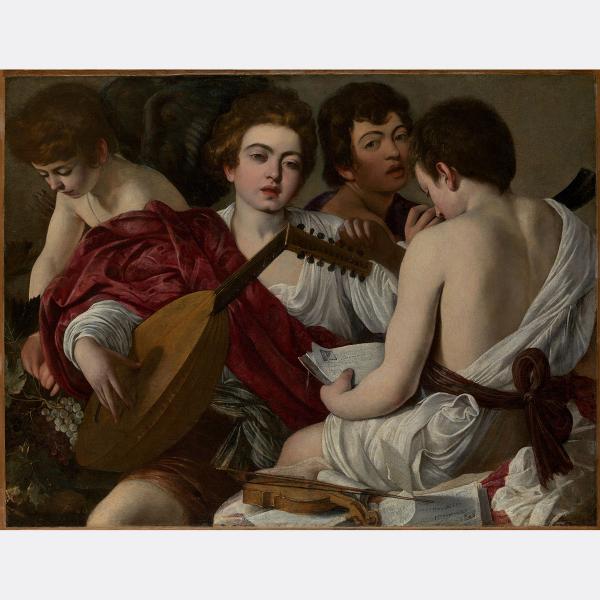The Musicians
Artwork Details
- Title: The Musicians
- Artist: Caravaggio (Michelangelo Merisi) (Italian, Milan or Caravaggio 1571–1610 Porto Ercole)
- Date: 1597
- Medium: Oil on canvas
- Dimensions: 36 1/4 x 46 5/8 in. (92.1 x 118.4 cm)
- Classification: Paintings
- Credit Line: Rogers Fund, 1952
- Object Number: 52.81
- Curatorial Department: European Paintings
Audio

5198. The Musicians
Caravaggio, 1597
ALASDAIR NICOLSON: I guess the thing that strikes me first about this picture is that it's clearly a moment when it's not performance. The lute player is tuning, and somebody is looking at some music; there’s an instrument lying to one side.
Hi. My name is Alasdair Nicolson, and I’m a composer.
DAVID PULLINS: Really Caravaggio's world, both among artists but especially among his patrons, was one that was filled with music and the support of music, so that the patron of this painting, for example, he also financed musical performances.
NARRATOR: Caravaggio’s familiarity with the world of music is on display here. But this isn’t a straightforward depiction of musicians getting ready to play. Associate Curator David Pullins.
DAVID PULLINS: In fact a painting like this is completely constructed, and so even the arrangement of these boys in this space, these are different models, and they probably never actually occupied all of the positions you see there at the same time. This is not a snapshot.
NARRATOR: Still, Caravaggio did become well-known for his direct observation of the world around him. The way he painted models–not as idealized Renaissance subjects–but as real people. David Pullins.
DAVID PULLINS: One of the ways that you see that here is in this range of the features of these models who are people who might have been actually just apprentices in his studio. He's really copying the kinds of faces and people he sees around him and that was considered really radical.
So it's hard for us to see them as not idealized and beautiful. They are those things, but they don't follow the kind of canons of beauty and ideal proportion that artists [saw] when they looked at classical sculpture and classical models.
NARRATOR: In other ways, though, Caravaggio was influenced by classical imagery and mythology. For example, there’s a boy at the left in the background. He’s eating very realistic grapes, but he also has...wings. Those choices tell us that he’s Cupid, the classical god of love.
DAVID PULLINS: Who's really fully allegorical. And so it kind of takes you from your lived experience out into an abstract one of symbols.
NARRATOR: Of course, a modern-day musician might read that winged figure differently.
ALASDAIR NICOLSON: Musicians, given the opportunity, will always help themselves to the food on offer in a rehearsal room and in the band room, et cetera. So somebody at the back eating grapes is no surprise.
More Artwork
Research Resources
The Met provides unparalleled resources for research and welcomes an international community of students and scholars. The Met's Open Access API is where creators and researchers can connect to the The Met collection. Open Access data and public domain images are available for unrestricted commercial and noncommercial use without permission or fee.
To request images under copyright and other restrictions, please use this Image Request form.
Feedback
We continue to research and examine historical and cultural context for objects in The Met collection. If you have comments or questions about this object record, please contact us using the form below. The Museum looks forward to receiving your comments.
